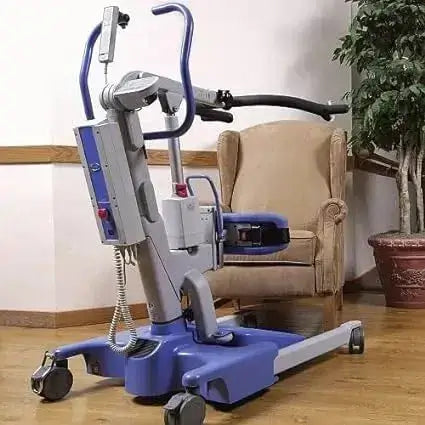Methods of Lifting a Patient
IIntroduction
In both healthcare settings and at-home care environments, the importance of safely lifting patients cannot be overstated. Incorrect handling techniques pose significant risks, including physical injury to both the patient and the caregiver, and can impact the dignity and comfort of those being cared for. This blog explores various methods to lift patients, focusing on ensuring safety and efficiency. We aim to equip caregivers with the knowledge to protect both themselves and their patients during transfers.

Understanding Patient Mobility Needs
Selecting the appropriate lifting technique for a patient is influenced by several critical factors: the patient's level of mobility, their overall health condition, and the specific environment where the lift is performed. Before any lifting attempt, it is essential to thoroughly assess the patient's physical capabilities and mental state. Mobility aids and assessments by healthcare professionals play a pivotal role in determining the safest method for patient handling. This evaluation helps prevent accidents and ensures that all movements are tailored to the individual needs of the patient, promoting safety and comfort.
Selecting the appropriate lifting technique for a patient is influenced by several critical factors: the patient's level of mobility, their overall health condition, and the specific environment where the lift is performed. Before any lifting attempt, it is essential to thoroughly assess the patient's physical capabilities and mental state. Mobility aids and assessments by healthcare professionals play a pivotal role in determining the safest method for patient handling. This evaluation helps prevent accidents and ensures that all movements are tailored to the individual needs of the patient, promoting safety and comfort.
Manual Lifting Techniques
Manual lifting techniques, like the log roll and two-person lifts, are fundamental skills for caregivers. However, other methods also play a vital role, such as the pivot technique and the scoop stretch. Proper posture and ergonomics are essential to prevent injuries during these maneuvers. Here are step-by-step instructions for a safe manual lift:
- Ensure the caregiver’s feet are shoulder-width apart.
- Bend at the knees, keeping the spine neutral.
- Communicate clearly with the patient throughout the process.
- Lift with the legs, not the back.
- Move smoothly to maintain balance.
Using Lifting Equipment
For situations requiring more frequent or complex lifts, mechanical aids such as hydraulic lifts and ceiling lifts are indispensable. These devices are designed with safety features that minimize risk and reduce the physical strain on caregivers. Each type of lift is suited to different settings and patient needs:
- Hydraulic Lifts: Ideal for their portability and ease of use in tight spaces.
- Ceiling Lifts: Best for continuous movement across rooms, providing a smooth transition for patients.
Utilizing these mechanical solutions offers consistency in patient handling and significantly decreases the likelihood of injury.
Role of Transfer Aids
Transfer aids like sliding boards and transfer poles are essential tools that facilitate the safe movement of patients between beds, chairs, or other areas. Choosing the right transfer aid involves considering the patient’s weight, their level of mobility, and typical transfer distances. Effective use of these aids not only enhances patient safety but also boosts the confidence of caregivers by providing additional support during transfers.
Training and Best Practices for Caregivers
Comprehensive training for caregivers is crucial to mastering safe lifting and transfer techniques. This training should encompass:
- Technique Training: Detailed walkthroughs of different lifting and transfer methods.
- Equipment Usage: Instructions on the correct use of mechanical lifts and transfer aids.
- Best Practices: Emphasis on continuous education, regular practice, and adherence to safety protocols.
Such educational initiatives ensure that caregivers are well-prepared to handle a variety of situations safely and effectively.
Legal and Ethical Considerations
Caregivers must be aware of the legal responsibilities and ethical considerations associated with patient handling. Negligence in following proper lifting protocols can lead to legal consequences and undermine the quality of patient care. It is also essential to respect patient rights and maintain their dignity throughout all procedures. This commitment to ethical care helps build trust and promotes a respectful caregiving environment.
Innovations in Patient Lifting
Recent advancements in technology are setting new standards in patient care. Innovations such as robotic lifting aids and AI-driven tools are beginning to reshape how caregivers interact with their patients. These technologies not only improve safety and efficiency but also introduce new capabilities for monitoring and executing patient transfers. As these tools evolve, they are expected to play a significant role in the future of healthcare.
Conclusion
This blog has discussed various techniques and tools essential for safely lifting and transferring patients. We have explored manual methods, mechanical aids, and the critical training required for caregivers to perform their duties safely and effectively. Continuous learning and adherence to established safety protocols are crucial for ensuring that patient handling is performed with the utmost care and respect. We encourage all caregivers to stay informed about the latest best practices and technological innovations in patient lifting. Your dedication to safe patient handling can make a profound difference in the quality of care you provide.
Let Us Know What You Think!
Your thoughts and questions are incredibly valuable to us, and we'd love to hear from you. If you have additional insights to share, your comments can spark meaningful discussions and enhance the collective knowledge of our community. Don't hesitate to ask any questions you may have; our team is here to provide answers and engage with you. So, please, take a moment to leave a comment or question below. Your input is much appreciated!


















Leave a comment